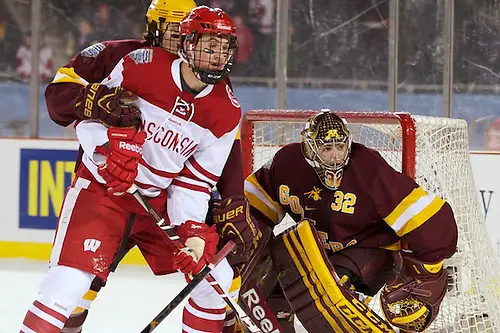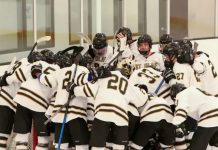
Six teams. Big expectations. B1G conference.
As the 2013-14 season begins and the teams that comprise the Big Ten prepare for their inaugural year, one thing is clear: That which is about to transpire will be as much theater as hockey, as much entertainment and branding as winning and losing — and every Big Ten program is on board with that.
“It almost seems like, in many ways, it’s a new job,” said Don Lucia, who begins his 15th season as coach at Minnesota. “It’s so fresh this year with entering a new conference, the Big Ten. Even though we’ve played many of the teams over the years, this is the first time we’ll be playing each of the Big Ten members four times. I think it’s going to be an exciting year, not only for us, but certainly our fans.”
Adding to that excitement is the exposure the league will receive from the Big Ten Network, which has committed to 22 regular season contests plus all games from the conference playoff tournament in St. Paul, Minn., next March.
Ohio State’s first-year coach Steve Rohlik said that the Big Ten Network will put each of its member hockey teams “on a stage.” Rohlik sees the exposure as a chance for the Buckeyes to get people “to understand that Ohio State is a tremendous opportunity to grow, to be a student-athlete and play college hockey.”
Mike Eaves, heading into his 12th season behind the Wisconsin bench, said that he sees opportunities for the sport itself to grow. “I think having that [the BTN] on the table will help people find the game, and we’ll get more fans because of that,” he said.
Five of the league’s six teams come from conferences with which they had long histories, while Penn State joins its first conference in its second season as a varsity program.
The transition from the now-defunct CCHA to the Big Ten is “not bittersweet,” said Tom Anastos, the former CCHA commissioner now in his third year as Michigan State’s coach. “I’m over it.”
“The CCHA had a very nice run,” Anastos said. “All the programs have found a home, and I think the Big Ten opportunity is very exciting, both for our member schools and I think for college hockey.”
“I think it’s big for everybody,” said the man charged with building Penn State’s program, Guy Gadowsky. “It’s incredibly important for college hockey. It’s obviously going to help tremendously with exposure across the board. I think we all benefit from this.”
Red Berenson, Michigan’s 30-year coach, said that how wide the influence of BTN’s coverage “has yet to be determined,” but he also said he’s “optimistic” about what may happen.
“The game will do justice if it gets the exposure,” Berenson said. “I’m really excited about the potential of the Big Ten Network.”
The sense is that if there’s enough exposure to college hockey played by schools with widely recognized names, all 59 Division I men’s ice hockey programs will benefit and the sport itself may grow.
“It’s a good product to watch,” Eaves said, “and the fact that exposure … will be at such a high and constant level, people will know where it is and where to find it.”
A good product to watch — that product being college hockey. And what about that?
Michigan finished 2012-13 in seventh place in the CCHA, missing the NCAA tournament for the first time in 23 years. The Wolverines did play their way into the last-ever game for the Mason Cup, which went to Notre Dame.
Michigan State was last in the CCHA and lost to Miami in the second round of the CCHA playoffs.
Minnesota tied for first in the WCHA in 2012-13 and bowed out in overtime to eventual champion Yale in the NCAA West Regional.
Ohio State finished last season fourth in the CCHA. The Buckeyes ended their season with a conference semifinal loss to Notre Dame.
Penn State played as an independent last season, compiling a record that was one game below .500.
Wisconsin finished 2012-13 in fourth place in the WCHA but won the Broadmoor Trophy as the league’s postseason champion. The Badgers were beaten 6-1, though, by Massachusetts-Lowell in the NCAA Northeast Regional.
Every one of these big teams from this big league comes into this first season hungry. The excitement of the new conference will generate interest and that each of these programs will attempt to provide the kind of product — as Eaves put it — that keeps consumers coming back for more.
It will be a month after the season begins, though, before these teams begin to play each other, and every one of these teams will be filling its schedule with as many as 14 nonconference games against foes both familiar and fairly new.
How all of this comes together — the excitement of the new conference, the hype driven by the BTN, the proverbial in-conference “beating up on each other,” the amount of nonconference play, the newness of many opponents — is what will make this first Big Ten season most interesting to watch.
Fortunately, for the price of cable television, we’ll be able to watch a good deal of it unfold.
Here’s how the Big Ten coaches picked their own conference in preseason. The individual team season previews are just a click away.
1. Wisconsin
The Badgers return an experienced team this season with a 10-member senior class, including Michael Mersch, who had 23 goals for Wisconsin as a junior. Read more
2. Minnesota
The Gophers lost just one senior … and a lot of talented players who opted for professional hockey rather than the Big Ten’s inaugural season. Read more
3. Michigan
As disappointing as 2012-13 was for Michigan, the Wolverines return a talented team and remain buoyed by their second-half play from last season, especially the play of sophomore goaltender Steve Racine. Read more
T4. Michigan State
The Spartans are a team in transition, a young team with a good sophomore goaltender of their own, Jake Hildebrand. Read more
T4. Ohio State
A new head coach brings new enthusiasm to the Buckeyes, a team with two questions to answer: Who’s going to score, and who’s going to replace All-American Brady Hjelle in net? Read more
6. Penn State
The Nittany Lions are a mystery — as much as to themselves as to the rest of the college hockey world. Entering their second season of Division I play, they’re nearly all underclassmen. They did go 3-2 against Big Ten opponents in 2012-13, though. Read more


